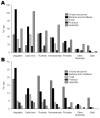Host range and emerging and reemerging pathogens - PubMed (original) (raw)
Host range and emerging and reemerging pathogens
Mark E J Woolhouse et al. Emerg Infect Dis. 2005 Dec.
Abstract
An updated literature survey identified 1,407 recognized species of human pathogen, 58% of which are zoonotic. Of the total, 177 are regarded as emerging or reemerging. Zoonotic pathogens are twice as likely to be in this category as are nonzoonotic pathogens. Emerging and reemerging pathogens are not strongly associated with particular types of nonhuman hosts, but they are most likely to have the broadest host ranges. Emerging and reemerging zoonoses are associated with a wide range of drivers, but changes in land use and agriculture and demographic and societal changes are most commonly cited. However, although zoonotic pathogens do represent the most likely source of emerging and reemerging infectious disease, only a small minority have proved capable of causing major epidemics in the human population.
Figures
Figure 1
Numbers of species of zoonotic pathogens associated with different types of nonhuman host. Note that some pathogens are associated with >1 host. A) All zoonotic species. B) Emerging and reemerging zoonotic species only.
Figure 2
Relationship between breadth of host range (as number of nonhuman host types, as listed in Figure 1) and the fraction of pathogen species regarded as emerging or reemerging. A total of 122 zoonotic species (10 of them emerging or reemerging) for which the host range is unknown are omitted.
Figure 3
Expected relationship between outbreak size (as fraction of the population affected) and 2 key epidemiologic parameters: I0 is the number of primary cases of infection introduced into the human population from an external source such as a zoonotic reservoir (increasing in the direction indicated); R0 is the basic reproduction number, a measure of the transmissibility of the infection with the human population (see text). The curves are obtained from a modified version of the Kermack-McKendrick equation and show that expected outbreak size is particularly sensitive to small changes in I0 or R0 when R0 is close to 1. Examples of zoonotic pathogens with R0>1, R0<1 and R0 close to 1 are shown. RIVF, Rift Valley fever virus. (Reprinted with permission from [23]).
Similar articles
- Emerging swine zoonoses.
Smith TC, Harper AL, Nair R, Wardyn SE, Hanson BM, Ferguson DD, Dressler AE. Smith TC, et al. Vector Borne Zoonotic Dis. 2011 Sep;11(9):1225-34. doi: 10.1089/vbz.2010.0182. Epub 2011 Mar 11. Vector Borne Zoonotic Dis. 2011. PMID: 21395424 Review. - Applying the theory of island biogeography to emerging pathogens: toward predicting the sources of future emerging zoonotic and vector-borne diseases.
Reperant LA. Reperant LA. Vector Borne Zoonotic Dis. 2010 Mar;10(2):105-10. doi: 10.1089/vbz.2008.0208. Vector Borne Zoonotic Dis. 2010. PMID: 19589061 - Looking in apes as a source of human pathogens.
Keita MB, Hamad I, Bittar F. Keita MB, et al. Microb Pathog. 2014 Dec;77:149-54. doi: 10.1016/j.micpath.2014.09.003. Epub 2014 Sep 16. Microb Pathog. 2014. PMID: 25220240 Review. - The human/animal interface: emergence and resurgence of zoonotic infectious diseases.
Greger M. Greger M. Crit Rev Microbiol. 2007;33(4):243-99. doi: 10.1080/10408410701647594. Crit Rev Microbiol. 2007. PMID: 18033595 Review. - Mathematically modeling spillovers of an emerging infectious zoonosis with an intermediate host.
Royce K, Fu F. Royce K, et al. PLoS One. 2020 Aug 26;15(8):e0237780. doi: 10.1371/journal.pone.0237780. eCollection 2020. PLoS One. 2020. PMID: 32845922 Free PMC article.
Cited by
- Understanding Viral Haemorrhagic Fevers: Virus Diversity, Vector Ecology, and Public Health Strategies.
Hewson R. Hewson R. Pathogens. 2024 Oct 18;13(10):909. doi: 10.3390/pathogens13100909. Pathogens. 2024. PMID: 39452780 Free PMC article. Review. - Rapid evolution leads to extensive genetic diversification of cattle flu Influenza D virus.
Limaye S, Lohar T, Dube H, Ramasamy S, Kale M, Kulkarni-Kale U, Kuchipudi SV. Limaye S, et al. Commun Biol. 2024 Oct 7;7(1):1276. doi: 10.1038/s42003-024-06954-4. Commun Biol. 2024. PMID: 39375524 Free PMC article. - Beyond COVID: towards a transdisciplinary synthesis for understanding responses and developing pandemic preparedness in Alaska.
van Doren TP, Brown RA, Chi G, Cochran P, Cueva K, Eichelberger L, Fried R, Fritz S, Hahn MB, Heintz R, Holen D, Johnson N, Lavoie J, Maxwell E, McNair L, Nicewonger T, Orttung RW, Petrov AN, Powell JE. van Doren TP, et al. Int J Circumpolar Health. 2024 Dec;83(1):2404273. doi: 10.1080/22423982.2024.2404273. Epub 2024 Sep 16. Int J Circumpolar Health. 2024. PMID: 39283062 Free PMC article. Review. - Transboundary viral diseases of pigs, poultry and ruminants in Southeast Asia: a systematic review.
Mai TN, Nguyen TT, Dang-Xuan S, Nguyen-Viet H, Unger F, Lee HS. Mai TN, et al. Vet Q. 2024 Dec;44(1):13-25. doi: 10.1080/01652176.2024.2397796. Epub 2024 Aug 30. Vet Q. 2024. PMID: 39210836 Free PMC article. - Investigating the workforce capacity and needs for animal disease surveillance and outbreak investigation: a mixed-methods study of veterinary services in Vietnam.
Auplish A, Tra Vu TT, Pham Duc P, Green AC, Tiwari H, Housen T, Stevenson M, Dhand N. Auplish A, et al. Front Vet Sci. 2024 Jul 26;11:1410606. doi: 10.3389/fvets.2024.1410606. eCollection 2024. Front Vet Sci. 2024. PMID: 39132434 Free PMC article.
References
- Institute of Medicine. Microbial threats to health: emergence, detection, and response. Washington: National Academy Press; 2003. - PubMed
MeSH terms
LinkOut - more resources
Full Text Sources
Other Literature Sources


